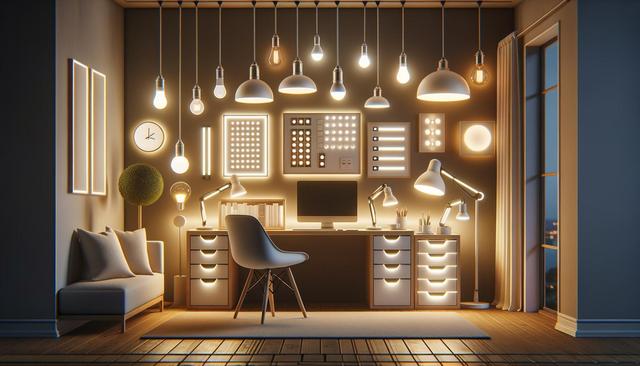What Are Smart Lighting Solutions?
Smart lighting solutions refer to lighting systems that can be controlled remotely through smartphones, tablets, or voice commands. These systems often connect via Wi-Fi, Bluetooth, or a smart hub, enabling users to adjust brightness, change color temperature, or schedule lighting events from anywhere. Unlike traditional lighting, smart lights offer automation and personalization options that suit various environments, from homes to workplaces.
These lighting systems are designed to integrate seamlessly with other smart home devices. Once connected, they can respond to triggers such as motion detection, voice prompts, or geolocation. This makes them not only convenient but also efficient. Some advanced smart lighting products even learn your preferences over time, adjusting automatically based on your daily routines.
Common features of smart lighting include:
- Remote access through mobile apps
- Integration with voice assistants
- Color and brightness customization
- Scheduling and automation
- Energy monitoring capabilities
Whether you’re looking to create a cozy atmosphere or enhance home security, smart lighting offers flexible solutions tailored to your needs.
Energy Efficiency and Cost Savings
One of the key advantages of smart lighting is its ability to reduce energy consumption. By using LED technology and allowing precise control over brightness and usage times, these systems help minimize unnecessary energy use. Many smart bulbs are designed to last significantly longer than traditional incandescent or halogen bulbs, further contributing to long-term savings.
Smart lighting also enables users to monitor their energy usage through companion apps. These insights can help identify areas where electricity is being wasted and encourage more efficient habits. For example, lights can be programmed to turn off automatically when no motion is detected or when you leave the house.
Here are a few ways smart lighting can help cut costs:
- Set schedules to avoid lights being left on unnecessarily
- Dim lights to save power when full brightness isn’t needed
- Use motion sensors to control lighting in low-traffic areas
Over time, the initial investment in smart lighting can pay off by lowering electric bills and reducing bulb replacement frequency.
Easy Control and Customization
Smart lighting systems give you the power to control your lighting environment in personalized ways. Whether you want a soft warm light for relaxing evenings or a bright white setting for focused work, smart bulbs can be adjusted to suit your mood or activity. These adjustments can be made via mobile apps, smart home hubs, or voice-controlled devices, offering flexibility and ease of use.
Customization goes beyond just brightness and color. Many systems allow you to create scenes or routines. For example, you could set a “morning” scene where the lights gradually brighten to help you wake up, or a “movie night” scene with dimmed, cozy lighting. This level of control enhances both comfort and convenience.
Some user-friendly features include:
- Voice control compatibility
- Geofencing to turn lights on/off based on your location
- Scheduling to match daily routines
- Group control of multiple lights at once
With such options, tailoring your lighting setup becomes an intuitive part of daily life.
Enhanced Security and Peace of Mind
Smart lighting also plays a role in improving home security. By simulating occupancy when you’re away, smart lights can deter potential intruders. Scheduling lights to turn on and off at varying intervals makes it appear like someone is home, providing an additional layer of protection.
Integration with other smart home devices amplifies this benefit. For instance, lights can be triggered by security cameras or motion sensors to alert you or scare off intruders. Some systems also allow you to receive alerts if lights are turned on unexpectedly, enabling real-time monitoring and quick responses.
Important security features include:
- Remote access for instant checks
- Integration with alarm and camera systems
- Customizable routines for vacation mode
- Motion-activated lighting in entryways and garages
These features not only enhance physical security but also offer peace of mind, knowing your home is being looked after even when you’re not there.
Installation and Compatibility Considerations
Setting up smart lighting is generally straightforward, even for those without technical expertise. Most systems are designed for plug-and-play functionality, meaning you can screw in a bulb, connect it to your network, and start customizing settings within minutes. Some setups may require a dedicated hub, while others operate independently through Wi-Fi or Bluetooth.
When choosing a smart lighting system, it’s important to consider compatibility with your existing devices and ecosystem. Not all smart lights work with every voice assistant or smart home hub. Checking compatibility before purchasing can save time and ensure seamless integration.
Things to keep in mind when installing smart lighting:
- Ensure your Wi-Fi network is stable and has sufficient range
- Check whether a hub is required for specific functions
- Look for systems that are compatible with your smart assistant
- Consider the number of lights and rooms you want to automate
Proper planning during installation will help you get the most out of your smart lighting system and avoid potential issues later on.
Final Thoughts: Is Smart Lighting Right for You?
Smart lighting solutions offer a blend of convenience, customization, and energy efficiency that can significantly enhance your everyday experience. Whether you’re looking to reduce utility costs, increase home security, or simply enjoy greater control over your lighting environment, smart lights provide practical and accessible options. With easy setup and wide compatibility, they are a great addition to both new and existing smart home systems.
For those new to home automation, smart lighting serves as an excellent starting point. It delivers immediate benefits without requiring major changes to your home’s infrastructure. As you explore your options, consider your lifestyle, budget, and the specific features that would improve your comfort and control. Making the switch to smart lighting can be a meaningful step toward a more connected and efficient living space.


